1. Arrive early
For the next seven days, see if you can be early for scheduled appointments. Notice how this impacts your state of mind. Do meetings feel more spacious? Do you feel more relaxed and better prepared? Do you feel that more is actually accomplished? Sub-rule to Practice 1: If you are late, relax. Just be late. Don’t punish yourself.
2. Focus on strengths
We often waste time focusing on what isn’t working, which spills over into time required to deal with bruised feelings. If you’re looking for what isn’t working, you may notice a lot, but you’ll limit what you can learn and use. Look for strengths, in yourself and others, as a conscious practice, and you will find how much more energy—and time—you have to accomplish things. Notice your state of mind during this practice. What supports you in this practice, and what gets in the way?
3. Take a break for a breakthrough
Take a few minutes each day to step out of conventional clock time. Taking this break may lead to a breakthrough, since many of our best ideas arise when we let our minds relax and wander. By relaxing our focus, we can be open to creative impulses, surprising questions, and, at times, robust answers. Each day, for the next seven days, spend ten minutes on not focusing. Just let your mind wander; get up, move to a different space. Be aware of your breath, your body, your walking; notice your surroundings as though seeing things through fresh eyes. Bring a heightened sense of awareness to sensations of sight, sound, smell, and touch.
Read More






